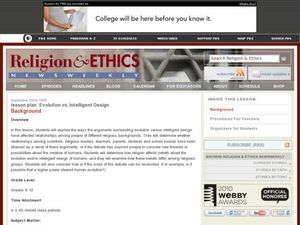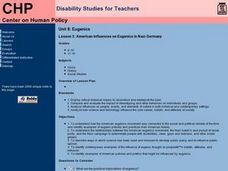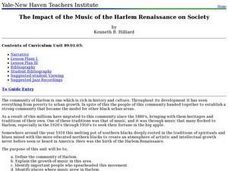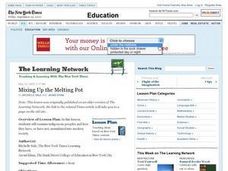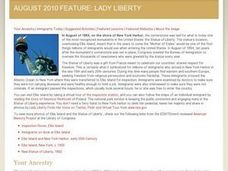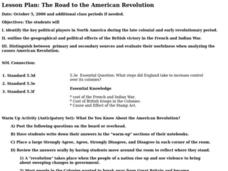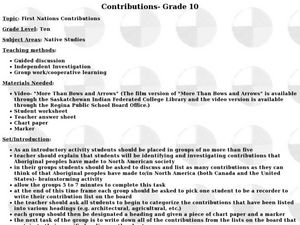Curated OER
Evolution vs. Intelligent Design
Ninth graders explore the arguments surrounding evolution versus intelligent design have affected relationships among people of different religious backgrounds. In this ethics lesson plan, 9th graders determine whether relationships...
Curated OER
Catch the Gullah Beat: Rhythm and Percussion
Students explore the Gullah culture. In this social studies instructional activity, students construct and play instruments similar to those of the Gullah people.
Curated OER
Continents of the World
Second graders participate in a lesson about how people are the same, how people are different and where the continents are located. They go on a trip around the woworld to visit a country in each continent.
Curated OER
Halloween
Students explore the history of Halloween and what people do at Halloween. Also, the compare Halloween with Lantern Festival and Ghosts' Day in Taiwan.
Curated OER
American Influences on Eugenics in Nazi Germany
Students examine the Eugenics movement in America. They discover the Nazi's belief in racial purity and how it relates to Eugenics. They also analyze how science has been influential in creating public policy.
Curated OER
The Impact of the Music of the Harlem Renaissance on Society
Students define the community of Harlem. They explain the growth of music in this area and identify important people who spearheaded this movement. They identify places where music grew in Harlem and establish a visual as well as an...
Curated OER
Mixing Up the Melting Pot
Students examine the cultures of indigenous peoples and how they have or have not assimilated into modern society. They create reports with recommendations on how the Nukak of Columbia could be assimilated into society.
Curated OER
What Can You Do?
Learners explore reasons for the destruction of the wetlands and identify ways people can help protect them. They create and design a wetlands conservation poster to be presented to the class.
Curated OER
Lady Liberty: The New Colossus
Students research the history of the Statue of Liberty and the symbols associated with it. They read and discuss Emma Lazarus' poem and why it should persuade people to donate money to bring the statue to America. Students role-play as...
Curated OER
Get Out the Vote!
Young scholars discuss importance of voting within a democracy, and investigate reasons why people vote, and why they don't. Students then conduct survey, make hypotheses about voter motivation, and develop materials to promote voting...
Curated OER
What Do We Know About Africa?
First graders explore Africa, its geography and climate. After completing a KWL chart, 1st graders locate Africa on a globe and discuss how its location on the earth affects its climate. Using the Internet and a given fact sheet,...
Curated OER
Canadian Studies Exercise
In this Canadian studies worksheet, students fill in the blanks in 10 sentences, describe the significance of 5 notable people or events, and respond to 10 true and false questions pertaining to Canada and its history.
Curated OER
The Road to the American Revolution
Fifth graders explore the causes of the American Revolution. In this American Revolution lesson, 5th graders examine the people, places, and events that led to the outbreak of war in the colonies.
Curated OER
The Cold War at Home
Eleventh graders discover the perspective of Cold War on the American homefront. In this Cold War instructional activity, 11th graders watch Duck and Cover video segments that instruct citizens what to do in case of nuclear attack....
Curated OER
Contributions- Grade 10
Tenth graders investigate the contributions of Aboriginal peoples. In this native studies lesson plan, 10th graders watch "More Than Bows and Arrows." Students complete a handout that requires them to list the contributions they note in...
Curated OER
Places and Production
Learners calculate United States GDP and GDP per capita, use a choropleth map to acquire information, and create choropleth maps of GDP per capita in South America. They identify regions with high and low GDP per capita
Curated OER
Pyrotechnics for Pyromaniacs
Young scholars explore how chemistry is associated with the annual celebration of America's independence. They learn what gunpowder is made of, the anatomy of a firework, how noise is made in fireworks and the safety issues.
Curated OER
Molly's Pilgrim
Third graders recognize and discuss multi-ethnic nature of America's citizens through a variety of activities.
Curated OER
Uncharted Territory
Students examine what were preconceived perceptions of the areas Lewis and Clark explored. They compare and contrast past and modern maps of North America. They accurately place route and site information on the map.
Curated OER
Black Music: Its Message and Meaning
Students develop an appreciation for modern black music from a historical, political and lyrical perspective. They examine the political and the historical surge of the civil rights movement of the 1960's and how this surge directly or...
Curated OER
Slavery in Connecticut 1640-1848
Sixth graders explore ways to tie Afro-American history into the study of Connecticut. They compare Blacks in Connecticut with the different situations of Blacks in other parts of America. They study the period from 1848 to the present.
Curated OER
Being Me in the Face of Adversity - Americans Who Stood Up for Their Beliefs
Students identify important Americans from the colonial, revolutionary and slavery periods who are noted for standing up for their beliefs in the face of peer disapproval. They identify the importance of music in motivating and...
Curated OER
Coiling Geography "On the Pampas"
First graders are introduced to the rope coiling form of art used by the gaucho culture of South America. They read "On the Pampas" by Maria Cristina Brusca, view the illustrations of the coiling technique and create original pieces.
Curated OER
A Mayan Adventure - Special Assignment
Students role-play the role of a reporter for their school's newspaper. Pretending they are visiting Mexico and Central America, they research the answers to questions given to them by their teacher. They discuss their answers and the...


